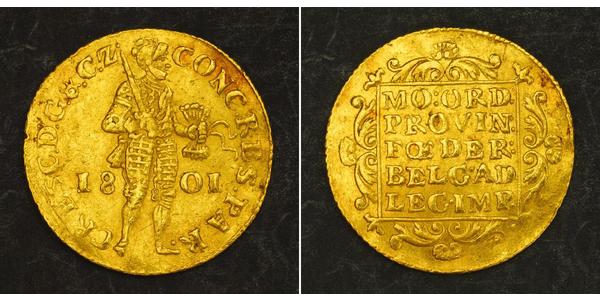(售价 $235.0)
1802, Netherlands, Batavian Republic. Scarce Gold Knight Ducat Coin. 3.49gm!
Mint Year: 1801 State: Batavian Republic Denomination: Gold Knight Ducat Reference: Friedberg 319, KM-11.3. R! Condition: Minor deposits, a few edge-nicks and minor scratches, otherwise XF! Mint Place: Dordrecht (this is one of four dates, which was also struck in secret by the Germans in 1812, according to recent studies!) Material: Pure Gold! Diameter: 22mm Weight: 3.49gm
Obverse: Knight standing right in armor, shouldering sword and holding a bundle of arrows in left hand. Date (18-01) split in fields. Legend: CONCORDIA . RES PAR . CRESC . D . G . & . C . Z . Expanded: "CONCORDIA RES PARvae CREScunt..." Translated: "Through concord little things grow (Union is strength) "
Reverse: Legend in five lines inside ornate square. Fields around decorated with floral ornaments. Legend: MO : ORD : PROVIN : FOEDER . BELG AD LEG . IMP Expanded: "MOneta ORDinum PROVINciarum FOEDERatorum BELGicarum AD LEGem IMPerii" Translated: "Coin of government of the provincial federation of Belgium Conforming with the law of the Imperial."
Minted in Holland beginning in the 17th century to fuel its extraordinary tenure as the world's foremost commercial trader, the Netherlands one ducat gold coin offers both strong visual appeal and a scarcity value that could command a healthy premium in the years to come. The first Netherlands trade ducat was issued in 1487 under Phillip the Fair and a coin very similar to the one depicted above has been minted more or less continuously from the early 1600s on. The net fine weight of 3.5 grams gold never changed to the modern era. The trade ducat is minted as a gold bullion coin even today. Only the Venetian ducat has enjoyed greater longevity. The obverse of the famed ducat coin depicts a knight holding a bundle of arrows signifying the unity of the six northern provinces under the 1579 Union of Utrecht -- a declaration of independence from Spain. The motto Concordia Res Parvae Crescunt translates to "the union makes small things grow." The legend on the reverse translates to "money of the provinces of the United Netherlands according to the law of the empire."
The Batavian Republic (Dutch: Bataafse Republiek) was the successor of the Republic of the United Netherlands. It was proclaimed on January 19, 1795 and ended on June 5, 1806 with the accession of Louis Bonaparte to the throne of the Kingdom of Holland.
The new Republic enjoyed widespread support from the Dutch population and was the product of a genuine popular revolution. Nevertheless, it clearly was founded with the armed support of the revolutionary French Republic. The Batavian Republic became a client state of first that "sister-republic," and later of the French Empire of Napoleon Bonaparte, and its politics was deeply influenced by the French who supported no less than three coups d'état to bring the different political factions to power that France favored at different moments in her own historical development. Nevertheless, the process of creating a written Dutch constitution was mainly driven by internal political factors, not by French influence. That is, until Napoleon forced the Dutch government to accept his brother as monarch.
The political, economic and social reforms that were brought about during the relatively short duration of the Batavian Republic have had a lasting impact. The confederal structure of the old Dutch Republic was permanently replaced by a unitary state. For the first time in Dutch history, the constitution that was adopted in 1798 had a genuinely democratic character (despite the fact that it was pushed through after a coup d'état). For a while the Republic was governed democratically, though the coup d'état of 1801 put an authoritarian regime in power, after another change in constitution. Nevertheless, the memory of this brief experiment with democracy helped smooth the transition to a democratic government in 1848. A type of ministerial government was introduced for the first time in Dutch history and many of the current government departments date their history back to this period.
Though the Batavian Republic was a client state, its successive governments tried their best to maintain a modicum of independence and to serve Dutch interests even where those clashed with those of their French overseers. This perceived obduracy led to the eventual demise of the Republic when the short-lived experiment with the (again authoritarian) regime of "Grand Pensionary" Schimmelpenninck produced insufficient docility in the eyes of Napoleon. The new king, Louis Napoleon, surprisingly did not slavishly follow French dictates either.
Only 1$ shipping for each additional coin purchased!
Tetradrachm 馬其頓王國 (808 BC - 168 BC) 銀 亚历山大大帝 (356BC-323BC)
本组有 202 钱币 / 195 售价
⇑
2 Krone 丹麦 銀 克里斯蒂安九世 (1818-1906)
本组有 8 钱币 / 8 售价
⇑







-300-150-iVYKbzbiO6MAAAFLcSj6AgfX.jpg)








